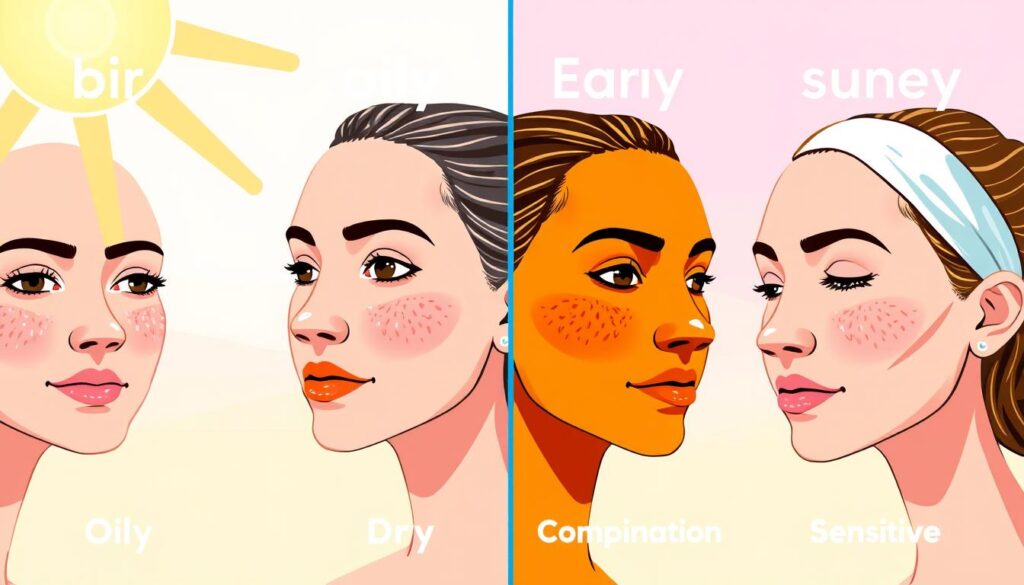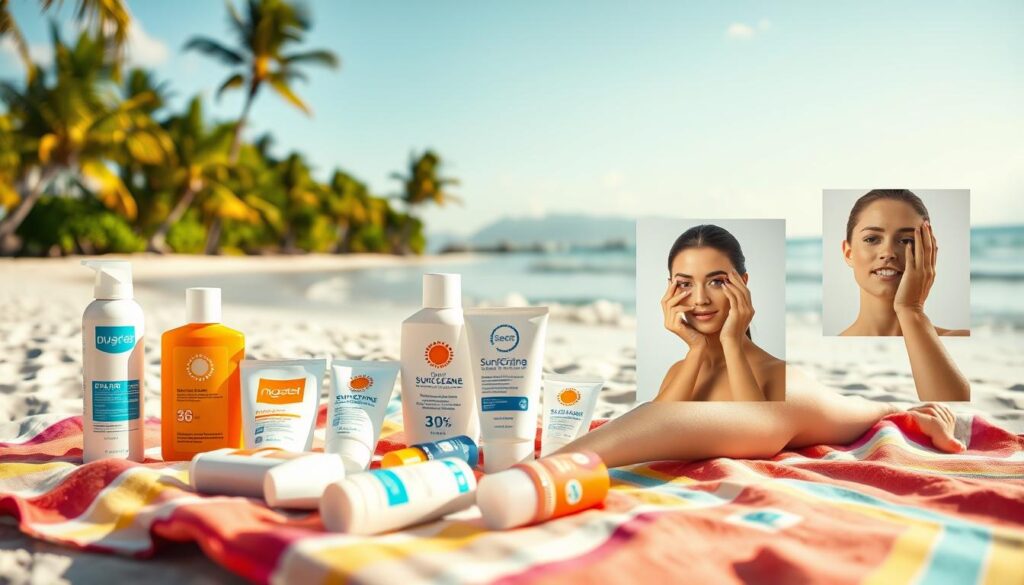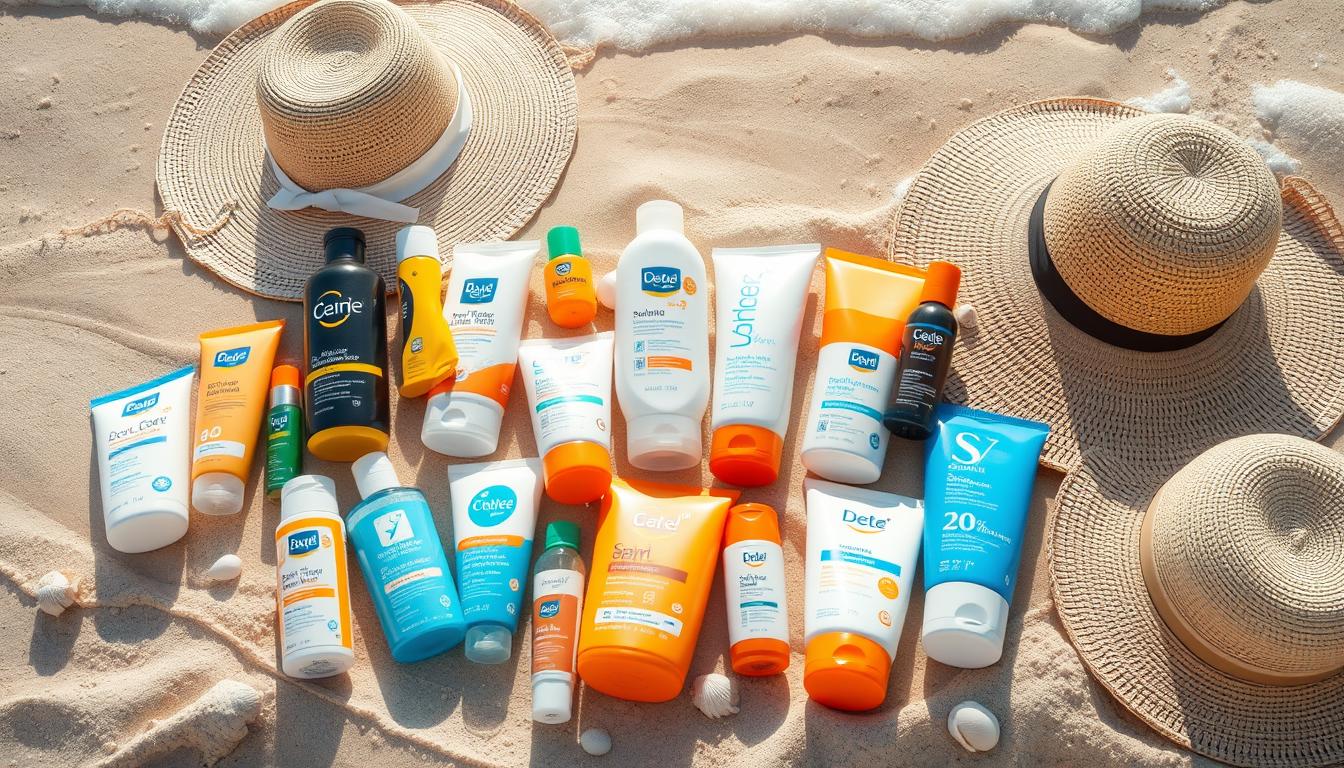Protecting our skin from the sun’s harmful rays is crucial for maintaining healthy, youthful-looking complexions. But with the overwhelming array of sunscreen options available, finding the right formula for our unique skin types can be a daunting task. In this comprehensive guide, we’ll explore the key factors to consider when selecting the perfect sunscreen to shield our skin from the sun’s damaging effects.
Key Takeaways
- Understand the importance of UV protection in daily skincare routines
- Decipher SPF ratings and broad-spectrum coverage for optimal sun protection
- Discover the different types of sunscreen formulations and how to choose based on your skin type
- Learn about special considerations for sensitive and acne-prone skin
- Explore the effects of melanin and skin tone on sunscreen selection
Understanding the Importance of UV Protection in Daily Skincare
UV protection is a crucial aspect of any effective skincare routine. Exposure to harmful ultraviolet (UV) rays can have detrimental effects on our skin’s health, leading to premature aging, sun damage, and an increased risk of skin cancer. As we delve into the significance of UV protection, let’s explore the differences between UVA and UVB rays and their unique impacts on our skin.
UVA vs UVB Rays and Their Effects on Skin
UVA rays, the longer wavelength UV radiation, can penetrate deep into the skin, causing damage to the collagen and elastin fibers that keep our skin looking youthful. Prolonged exposure to UVA rays can lead to the development of fine lines, wrinkles, and age spots. On the other hand, UVB rays, the shorter wavelength UV radiation, primarily affect the outermost layer of the skin, causing sunburns and increasing the risk of skin cancer.
Year-Round Sun Protection Benefits
It’s important to note that UV protection should be a year-round concern, not just during the summer months. Even on cloudy or overcast days, harmful UV rays can still reach our skin and cause long-term damage. Incorporating a broad-spectrum sunscreen with an appropriate SPF into our daily skincare routine is essential for maintaining the health and youthful appearance of our skin, regardless of the season.
By understanding the importance of UV protection and taking the necessary steps to shield our skin from harmful rays, we can enjoy the benefits of healthy, radiant skin for years to come.
Decoding SPF Ratings and Broad Spectrum Protection
When it comes to protecting our skin from the sun’s harmful rays, understanding SPF (Sun Protection Factor) and broad spectrum protection is crucial. Let’s dive in and unravel the mystery behind these important sunscreen terms.
SPF is a measure of how well a sunscreen can protect our skin from UVB rays, the primary cause of sunburns. The higher the SPF, the more effective the sunscreen is at blocking these rays. For example, an SPF 30 sunscreen blocks approximately 97% of UVB rays, while an SPF 50 sunscreen blocks around 98%.
Broad spectrum protection, on the other hand, refers to a sunscreen’s ability to shield us from both UVB and UVA rays. UVA rays can penetrate deeper into the skin, causing long-term damage and contributing to premature aging and skin cancer. Choosing a sunscreen labeled as “broad spectrum” ensures that we’re getting comprehensive protection against the full spectrum of harmful UV radiation.
- When selecting a sunscreen, look for one with an SPF of at least 30 and a broad spectrum label.
- For extended outdoor activities or water sports, opt for a water-resistant formula with a higher SPF, such as 50 or higher.
- Reapply sunscreen every 2 hours, or more frequently if swimming or sweating.
By understanding the importance of SPF and broad spectrum protection, we can make informed choices to keep our skin safe and healthy, no matter the season or our outdoor activities.
Different Types of Sunscreen Formulations
When it comes to protecting your skin from the sun’s harmful UV rays, there are various sunscreen formulations to choose from. Understanding the differences between chemical, mineral, and hybrid sunscreens can help you select the right one for your skin type and preferences.
Chemical Sunscreens Explained
Chemical sunscreens work by absorbing UV radiation and converting it into heat, which is then released from the skin. These formulations often contain active ingredients like oxybenzone, avobenzone, and octinoxate, which are effective at shielding the skin from both UVA and UVB rays. Chemical sunscreens are generally lightweight, easy to apply, and blend seamlessly into the skin.
Mineral-Based Sun Protection Options
Mineral or physical sunscreens, on the other hand, work by reflecting and scattering UV rays away from the skin. The active ingredients in these formulations are typically zinc oxide and titanium dioxide, which create a physical barrier against the sun’s rays. Mineral sunscreens are often preferred by those with sensitive skin, as they tend to be less irritating than their chemical counterparts.
Hybrid Formulations Benefits
For the best of both worlds, consider a hybrid sunscreen that combines chemical and mineral active ingredients. These formulations can provide broad-spectrum protection while offering a more cosmetically appealing texture and application. Hybrid sunscreens often offer a balance of protection, comfort, and ease of use, making them a popular choice for many skin types.
When selecting a sunscreen, it’s important to consider your individual skin needs, personal preferences, and the level of protection required. Experiment with different formulations to find the one that provides the best coverage and feels most comfortable on your skin.
Matching Sunscreen to Your Skin Type
Choosing the right sunscreen can be a game-changer when it comes to effective sun protection. But with the wide array of options on the market, how do you know which one is the best fit for your unique skin type? Fear not, we’re here to guide you through the process and help you find your perfect sunscreen match.
Whether you have oily, dry, combination, or normal skin, there’s a sunscreen formulation tailored just for you. Oily skin types do best with oil-free, mattifying sunscreens that won’t clog pores or leave a greasy residue. Dry skin, on the other hand, craves hydrating, moisturizing sunscreens that lock in moisture and prevent flakiness. Those with combination skin may need to experiment to find the right balance, while normal skin types can often use a wide range of sunscreen formulas.
But it’s not just about skin type – personal preferences and concerns should also factor into your sunscreen selection. If you have sensitive skin, look for mineral-based, fragrance-free options. Acne-prone individuals may want to steer clear of thick, heavy creams in favor of lighter, non-comedogenic formulas. And for those who dislike the chalky white cast sometimes associated with sunscreens, there are tinted and sheer varieties designed to blend seamlessly into all skin tones.
By taking the time to understand your Skin Type and personal needs, you can find the perfect Sunscreen Selection for Personalized Protection that’ll have you covered (quite literally) all year round.

Special Considerations for Sensitive and Acne-Prone Skin
When it comes to sun protection, individuals with sensitive or acne-prone skin require special attention. These skin types have unique needs that must be addressed to ensure effective and safe sun protection. Let’s explore the key considerations for these skin types and uncover the dermatologist-recommended options that can provide the necessary shield against harmful UV rays.
Ingredients to Avoid
For those with sensitive or acne-prone skin, certain sunscreen ingredients can trigger unwanted reactions, exacerbate existing conditions, or clog pores. Some common culprits to steer clear of include:
- Fragrances and dyes
- Alcohol-based formulas
- Oxybenzone and avobenzone
- Heavy oils and thick, creamy textures
Dermatologist-Recommended Options
Seeking the guidance of a dermatologist can be invaluable when selecting the right sunscreen for sensitive or acne-prone skin. Dermatologists often recommend mineral-based sunscreens that use active ingredients like zinc oxide or titanium dioxide, as they tend to be gentler and less irritating. Additionally, oil-free, non-comedogenic formulas can help minimize the risk of clogged pores and breakouts.
When exploring dermatologist-recommended options, look for sunscreens that are specifically formulated for Sensitive Skin or Acne-Prone Skin. These products are designed to provide effective UV protection while addressing the unique needs of these skin types.
Incorporating a suitable sunscreen into your daily skincare routine is crucial for maintaining the health and appearance of sensitive or acne-prone skin. By understanding the ingredients to avoid and seeking out dermatologist-recommended options, you can enjoy the benefits of Dermatologist Recommended sun protection without compromising your skin’s well-being.
Understanding Water Resistant Formulas
When it comes to protecting our skin from the sun’s harmful rays, the concept of water resistance is often overlooked. However, Water Resistant Sunscreen and Sweat-Proof Protection are crucial considerations, especially for those who lead an active lifestyle or spend time in the water.
Water resistance in sunscreens refers to the product’s ability to maintain its efficacy and stay on the skin even when exposed to water, sweat, or other moisture. This is an important factor when choosing the right sunscreen for activities like swimming, beach days, or intense outdoor workouts.
- Water Resistant Sunscreens: These formulations are designed to withstand water exposure for a specific duration, typically 40 or 80 minutes. This means they will continue to provide protection even after swimming or sweating.
- Sweat-Proof Protection: Sunscreens with a sweat-proof formula are ideal for active individuals who want to ensure their skin is shielded from UV rays during high-intensity activities.
When selecting a water-resistant or sweat-proof sunscreen, it’s essential to check the product label for the water resistance time and apply the sunscreen generously to ensure optimal coverage. Reapplying the sunscreen as directed is also crucial to maintain the level of protection throughout the day.
By understanding the benefits of water-resistant and sweat-proof sunscreens, you can make an informed decision to keep your skin protected, no matter the activity or weather conditions. Prioritizing these formulas can help you enjoy the great outdoors with confidence and peace of mind.
How Melanin and Skin Tone Affect Sunscreen Choice
When it comes to sun protection, *melanin* and skin tone play a crucial role in determining the right sunscreen for your needs. Melanin, the pigment responsible for your skin’s color, provides natural UV protection. However, the level of melanin varies significantly across different skin tones, and this can impact how sunscreen interacts with and protects your skin.
Specific Needs for Different Skin Tones
Individuals with lighter skin tones typically have lower melanin levels, making them more susceptible to sun damage and sunburns. They often require sunscreens with higher sun protection factor (SPF) to ensure adequate coverage. On the other hand, those with darker *skin tones* have higher melanin levels, which provides a natural layer of protection against UV rays. However, they may still need to be vigilant about sun exposure and choose sunscreens that cater to their specific needs.
Avoiding White Cast on Darker Skin
One common concern for people with darker *skin tones* is the dreaded white cast that can occur when using certain sunscreen formulations. The white cast is caused by the mineral ingredients, such as zinc oxide or titanium dioxide, used in some sunscreens. To avoid this, it’s essential to look for sunscreens that are specifically formulated for darker skin tones. These products often use micronized or tinted versions of the mineral filters, which blend seamlessly into the skin without leaving a noticeable white residue.
Ultimately, understanding how *melanin* and *skin tone* influence your sunscreen needs is crucial for ensuring effective and comfortable sun protection. By choosing the right sunscreen for your individual skin type and tone, you can enjoy the outdoors with confidence, knowing your skin is well-protected from the harmful effects of UV radiation.
Application Techniques for Maximum Protection
Achieving comprehensive sun protection starts with proper Sunscreen Application. To ensure you get the most out of your sunscreen, follow these expert tips for Even Coverage and Reapplication throughout the day.
First and foremost, apply a generous amount of sunscreen. The recommended dose is about 1 ounce (a shot glass full) to cover your entire body. Don’t skimp – use enough to thoroughly coat all exposed areas, including often-missed spots like the lips, ears, and around the eyes.
- Apply sunscreen 15-30 minutes before going outdoors to allow it to fully absorb into the skin.
- Reapply every 2 hours, or more frequently if swimming or sweating.
- Don’t forget to reapply after toweling off, as sunscreen can be easily removed.
For Even Coverage, work the sunscreen in using gentle, circular motions. Pay close attention to commonly missed areas like the hairline, around the ears, and down the neck. Blend well to ensure there are no shiny or white streaky patches.

Regular Reapplication is key to maintaining comprehensive sun protection throughout the day. Set a timer to remind yourself, and keep a travel-size sunscreen on hand for easy touchups. With these simple techniques, you can confidently enjoy the outdoors with the protection your skin deserves.
Common Sunscreen Myths and Facts
When it comes to sun protection, separating fact from fiction is crucial. Let’s debunk some common sunscreen myths and shed light on science-backed sun protection methods.
Debunking Popular Misconceptions
One persistent myth is that sunscreen can completely prevent sunburns. While sunscreen is an essential tool, it’s not a magical force field. Proper application and reapplication are key to maximizing its effectiveness. Another myth is that sunscreen causes vitamin D deficiency. In reality, the benefits of sun protection far outweigh any potential impact on vitamin D levels.
Science-Backed Protection Methods
- Use a broad-spectrum sunscreen with an SPF of 30 or higher, applying it generously and reapplying every 2 hours, especially after sweating or swimming.
- Seek shade during peak sun hours and wear protective clothing, such as wide-brimmed hats and long-sleeved shirts, to complement your sunscreen.
- Remember that sunscreen is just one part of a comprehensive sun protection regimen. Combining it with other measures, like sun-blocking accessories and seeking shade, provides the best defense against harmful UV rays.
By understanding the facts and dismissing common sunscreen myths, you can make informed decisions to keep your skin safe and healthy all year round. Embrace science-backed sun protection methods and enjoy the outdoors with confidence.
Signs It’s Time to Replace Your Sunscreen
Maintaining the effectiveness of your sunscreen is crucial for providing ongoing protection against the sun’s harmful UV rays. As we all know, Sunscreen Expiration and product effectiveness can diminish over time, signaling the need for a replacement. Let’s explore the key indicators that suggest it’s time to swap out your current sunscreen for a fresh, reliable formula.
One of the most obvious signs is the Sunscreen Expiration date printed on the packaging. Sunscreens typically have a shelf life of 12 to 18 months, and using an expired product means you’re not getting the promised Product Effectiveness. Pay close attention to this date and be diligent about replacing your sunscreen before it expires.
- Changes in the sunscreen’s texture or consistency, such as it becoming thicker, clumpier, or more watery, can indicate that the formula has degraded and may no longer provide adequate protection.
- An unfamiliar or unpleasant smell is another red flag that your sunscreen has gone bad and should be replaced.
- If you notice the sunscreen’s color has changed or it has developed a white, chalky appearance, these are telltale signs that the active ingredients have started to break down, compromising the Product Effectiveness.
By staying vigilant and recognizing these signs, you can ensure that your sunscreen is working hard to safeguard your skin from the sun’s damaging rays. Regularly checking your sunscreen and replacing it as needed will help maintain the Sunscreen Expiration and Product Effectiveness you depend on for optimal sun protection.
Conclusion
As we conclude our journey to finding the perfect sunscreen for your skin type, we’re reminded of the unwavering importance of consistent sun protection for maintaining a healthy, radiant complexion throughout the year. From understanding the differences between UVA and UVB rays to decoding SPF ratings and selecting the right formula for your skin, we’ve covered a wealth of knowledge to help you make informed choices.
Ultimately, the key to healthy skin lies in your dedication to sunscreen application, regardless of the season or weather conditions. By making sun protection a seamless part of your daily routine, you’re taking a proactive step toward safeguarding your skin from the harmful effects of UV exposure. Remember, protecting your skin now will pay dividends in the form of a youthful, vibrant appearance for years to come.
So, let’s embrace the power of sunscreen and make it your trusted ally in achieving a radiant complexion that radiates confidence and well-being. With the right knowledge and a commitment to consistent sun protection, you’re on the path to maintaining healthy, glowing skin that will captivate and inspire those around you.



